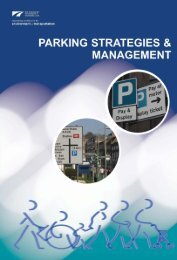Level 2 and 3 Diploma in Business Support (4475-12/13)
Level 2 and 3 Diploma in Business Support (4475-12/13)
Level 2 and 3 Diploma in Business Support (4475-12/13)
You also want an ePaper? Increase the reach of your titles
YUMPU automatically turns print PDFs into web optimized ePapers that Google loves.
Unit 208 Delivery of effective customer service<br />
Notes for guidance<br />
Outcome 1 Be able to describe the pr<strong>in</strong>ciples of customer service<br />
1.1 Good customer service is about<br />
• ensur<strong>in</strong>g customer needs are met<br />
• encourag<strong>in</strong>g customer loyalty<br />
• form<strong>in</strong>g a relationship with customers<br />
• ensur<strong>in</strong>g customers leave happy <strong>and</strong> return<br />
• ensur<strong>in</strong>g customers pass on positive feedback to others.<br />
1.2 Hav<strong>in</strong>g experienced a certa<strong>in</strong> level of customer service from an organisation, customers then<br />
come to expect that level of customer service whether good or bad.<br />
Good customer service can give an organisation an edge over its competitors while poor service<br />
can result <strong>in</strong> a loss of bus<strong>in</strong>ess <strong>and</strong> a reputation for poor service can be difficult to change.<br />
1.3 A customer can be an <strong>in</strong>dividual or an organisation. Customers can be <strong>in</strong>ternal eg from another<br />
part of the same organisation or colleagues; external eg <strong>in</strong>dividuals, bus<strong>in</strong>esses <strong>in</strong>clud<strong>in</strong>g<br />
suppliers.<br />
1.4 Different customers will have different needs <strong>and</strong> expectations from an organisation eg that<br />
timescales are met, promises kept, there’s value for money, quality presentation, employees are<br />
knowledgeable <strong>and</strong> friendly, products are fit for use/purpose, are reliable, easy to use.<br />
Other types of customer needs exist where customers’ health, language skills, age or cultural<br />
background or learn<strong>in</strong>g difficulties <strong>in</strong>fluence how a service provider may need to adapt their<br />
behaviour <strong>and</strong> adapt their methods of communication to meet these <strong>in</strong>dividual needs.<br />
1.5 Customer service <strong>in</strong>formation/records – there is a range of customer service<br />
<strong>in</strong>formation/records which organisations may reta<strong>in</strong> eg personal data – customer’s name,<br />
address, account details, previous purchases; customer feedback on a product or service – user<br />
evaluation; warranty/guarantee records; records of compla<strong>in</strong>ts.<br />
1.6 Products are tangible ie a customer can buy a product like a car <strong>and</strong> own it. However, they<br />
cannot own a service. A product is produced by a manufactur<strong>in</strong>g process while you subscribe to<br />
a service. The ma<strong>in</strong> difference between provid<strong>in</strong>g products as opposed to a service is that more<br />
personal contact may be required when market<strong>in</strong>g a service as compared with market<strong>in</strong>g<br />
products. Provid<strong>in</strong>g a product may also <strong>in</strong>volve provid<strong>in</strong>g after-sales service as <strong>in</strong> help-l<strong>in</strong>e<br />
facilities follow<strong>in</strong>g the sale of a computer.<br />
1.7 An after sales service - provid<strong>in</strong>g support for a service or a product after purchase eg help-l<strong>in</strong>e<br />
facilities follow<strong>in</strong>g the sale of a computer. With a product the after sales service may <strong>in</strong>volve<br />
deal<strong>in</strong>g with warranties, guarantees, exchanges, repair agreements, refunds. As such there may<br />
be various terms, legal constra<strong>in</strong>ts <strong>and</strong> organisational policies which need to be considered.<br />
1.8 A USP - Unique Sell<strong>in</strong>g Po<strong>in</strong>t is what makes a product different or better from its competitor(s)<br />
eg price, packag<strong>in</strong>g, performance, market perception, quality, availability, meet<strong>in</strong>g deadl<strong>in</strong>es. A<br />
unique sell<strong>in</strong>g po<strong>in</strong>t or proposition (USP) def<strong>in</strong>es an organisation’s competitive advantage. An<br />
organisation must identify what makes it different from the competitors <strong>and</strong> emphasise these<br />
advantages <strong>in</strong> market<strong>in</strong>g thus <strong>in</strong>fluenc<strong>in</strong>g the customer’s choice of products <strong>and</strong> services.<br />
<strong>Level</strong> 2 <strong>and</strong> 3 <strong>Diploma</strong> <strong>in</strong> Bus<strong>in</strong>ess <strong>Support</strong> (<strong>4475</strong>-<strong>12</strong>/<strong>13</strong>) 89







